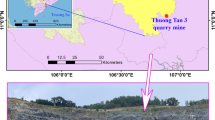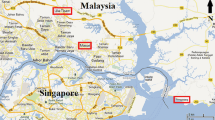Abstract
Ground vibration is one of the most undesirable effects of blasting operation in surface mines. Therefore, it seems that the prediction of ground vibrations with a high degree of accuracy is necessary to reduce environmental effects. This article proposes a novel swarm intelligence algorithm based on cuckoo search (NSICS) to create a precise equation for predicting the ground vibration produced by blasting operations in Miduk copper mine, Iran. To evaluate the proposed NSICS model, several empirical equations were also utilized. In this regard, 85 blasting events were considered, and the values of two effective parameters on the ground vibration, namely, maximum charge used per delay and distance between blast face and monitoring station, were measured. In addition, the values of peck particle velocity (PPV), as a vibration descriptor, were recorded in each blasting. Two performance indices, i.e., root mean square error and coefficient of multiple correlation (R 2), were used to determine the performance capacity of the proposed models. Comparing the values predicted by the models demonstrated that the proposed equation by NSICS is more reliable than empirical equations in predicting the PPV.












Similar content being viewed by others
References
Hustrulid W (1999) Blasting principles for open pit mining: general design concepts, vol 1. Balkema, Rotterdam
Singh TN, Dontha LK, Bhardwaj V (2008) Study into blast vibration and frequency using ANFIS and MVRA. Min Technol 117(3):116–121
Khandelwal M (2011) Blast-induced ground vibration prediction using support vector machine. Eng Comput 27:193–200. doi:10.1007/s00366-010-0190-x
Ghasemi E, Ataei M, Hashemolhosseini H (2012) Development of a fuzzy model for predicting ground vibration caused by rock blasting in surface mining. J Vib Control 19:755–770
Monjezi M, Hasanipanah M, Khandelwal M (2013) Evaluation and prediction of blast-induced ground vibration at Shur river dam, Iran, by artificial neural network. Neural Comput Appl 22:1637–1643
Trivedi R, Singh TN, Raina AK (2014) Prediction of blast-induced flyrock in Indian limestone mines using neural networks. J Rock Mech Geotech Eng 6:447–454
Jahed Armaghani D, Hajihassani M, Sohaei H, Mohamad ET, Marto A, Motaghedi H, Moghaddam MR (2015) Neuro-fuzzy technique to predict air-overpressure induced by blasting. Arab J Geosci. doi:10.1007/s12517-015-1984-3
Singh TN, Singh A, Singh CS (1994) Prediction of ground vibration induced by blasting. Indian Min Eng J 31–34:16
Khandelwal M, Singh TN (2009) Prediction of blast-induced ground vibration using artificial neural network. Int J Rock Mech Min Sci 46:1214–1222
Khandelwal M, Singh TN (2013) Application of an expert system to predict maximum explosive charge used per delay in surface mining. Rock Mech Rock Eng 46(6):1551–1558
Hasanipanah M, Monjezi M, Shahnazar A, Jahed Armaghani D, Farazmand A (2015) Feasibility of indirect determination of blast induced ground vibration based on support vector machine. Measurement 75:289–297
Khandelwal M, Singh TN (2007) Evaluation of blast-induced ground vibration predictors. Soil Dyn Earthq Eng 27:116–125
Hajihassani M, Jahed Armaghani D, Monjezi M, Tonnizam Mohamad E, Marto A (2015) Blast-induced air and ground vibration prediction: a particle swarm optimization-based artificial neural network approach. Environ Earth Sci 74(4):2799–2817
Khandelwal M, Saadat M (2015) A dimensional analysis approach to study blast-induced ground vibration. Rock Mech Rock Eng 48:727–735. doi:10.1007/s00603-014-0604-y
Amiri M, Bakhshandeh Amnieh H, Hasanipanah M, Mohammad Khanli L (2016) A new combination of artificial neural network and K-nearest neighbors models to predict blast-induced ground vibration and air-overpressure. Eng Comput. doi:10.1007/s00366-016-0442-5
Singh TN, Singh V (2005) An intelligent approach to prediction and control ground vibration in mines. Geotech Geol Eng 23:249–262
Khandelwal M, Kumar DL, Yellishetty M (2011) Application of soft computing to predict blast-induced ground vibration. Eng Comput 27(2):117–125
Konya CJ, Walter EJ (1990) Surface blast design. Prentice Hall, Englewood Cliffs
ISRM (1992) Suggested method for blast vibration monitoring. Int J Rock Mech Min Geomech Abstr 29:145–156
Duvall WI, Petkof B (1959) Spherical propagation of explosion generated strain pulses in rock. US Bureau of Mines Report of Investigation 5483
Langefors U, Kihlstrom B (1963) The modern technique of rock blasting. Wiley, New York
Davies B, Farmer IW, Attewell PB (1964) Ground vibrations from shallow sub-surface blasts. Engineer 217:553–559
Ambraseys NR, Hendron AJ (1968) Dynamic behavior of rock masses: rock mechanics in engineering practices. Wiley, London
Ghosh A, Daemen JK (1983) A simple new blast vibration predictor. In: Proceedings of the 24th US Symposium on Rock Mechanics, Texas, pp 151–161
Gupta RN, Roy P, Singh B (1987) On a blast induced blast vibration predictor for efficient blasting. In: Proceedings of the 22nd international conference on safety in Mines Research Institute, Beijing, pp 1015–1021
Pal Roy P (1991) Vibration control in an opencast mine based on improved blast vibration predictors. Min Sci Technol 12(2):157–165
Rai R, Singh TN (2004) A new predictor for ground vibration prediction and its comparison with other predictors. Indian J Eng Mater Sci 11(3):178–184
Jahed Armaghani D, Hajihassani M, Mohamad ET, Marto A, Noorani SA (2013) Blasting-induced flyrock and ground vibration prediction through an expert artificial neural network based on particle swarm optimization. Arab J Geosci. doi:10.1007/s12517-013-1174-0
Saadat M, Khandelwal M, Monjezi M (2014) An ANN-based approach to predict blast-induced ground vibration of Gol-E-Gohar iron ore mine, Iran. J Rock Mech Geotech Eng 6:67–76
Mohamed MT (2011) Performance of fuzzy logic and artificial neural network in prediction of ground and air vibrations. Int J Rock Mech Min Sci 48:845–851
Dehghani H, Ataee-pour M (2011) Development of a model to predict peak particle velocity in a blasting operation. Int J Rock Mech Min Sci 48:51–58
Verma AK, Singh TN (2013) Comparative study of cognitive systems for ground vibration measurements. Neural Comput Appl 22(Suppl 1):S341–S350
Armaghani Jahed, Momeni E, Abad SVANK, Khandelwal M (2015) Feasibility of ANFIS model for prediction of ground vibrations resulting from quarry blasting. Environ Earth Sci. doi:10.1007/s12665-015-4305-y
Iphar M, Yavuz M, Ak H (2008) Prediction of ground vibrations resulting from the blasting operations in an open-pit mine by adaptive neuro-fuzzy inference system. Environ Geol 56(1):97–107
Yang XS, Deb S (2009) Cuckoo search via lévy flights. World congress on nature and biologically inspired computing. In: IEEE, pp 210–214
Yang XS, Deb S (2010) Engineering optimization by cuckoo search. Int J Math Model Numer Optim 4:330–343
Gandomi AH, Talatahari S, Yang XS, Deb S (2012) Design optimization of truss structures using cuckoo search algorithm. Struct Des Tall Spec Build 22:1330–1349
Yang XS, Deb S (2012) Cuckoo search for inverse problems and topology optimization. In: Proceedings of international conference on advances in computing. Advances in intelligent systems and computing, vol 174:291–295. doi:10.1007/978-81-322-0740-5_35
Gandomi AH, Yang XS, Alavi AH (2013) Cuckoo search algorithm: a metaheuristic approach to solve structural optimization problems. Eng Comput 29:17–35
Fouladgar N, Lotfi Sh (2015) A novel approach for optimization in dynamic environments based on modified cuckoo search algorithm. Soft Comput. doi:10.1007/s00500-015-1951-7
Yang XS (2010) Nature-inspired metaheuristic algorithms, 2nd edn. Luniver Press, Frome
Fouladgar N, Lotfi Sh (2015) A novel swarm intelligence algorithm based on cuckoo search algorithm (NSICS). In: Intelligent computing theories and methodologies, Springer, New York, pp 587–596.
Acknowledgments
The authors would like to extend their appreciation to manager, engineers, and personnel of Miduk copper mine as well as Mr. Alireza Farazmand for providing the needed information and facilities that made this research possible.
Author information
Authors and Affiliations
Corresponding author
Rights and permissions
About this article
Cite this article
Fouladgar, N., Hasanipanah, M. & Bakhshandeh Amnieh, H. Application of cuckoo search algorithm to estimate peak particle velocity in mine blasting. Engineering with Computers 33, 181–189 (2017). https://doi.org/10.1007/s00366-016-0463-0
Received:
Accepted:
Published:
Issue Date:
DOI: https://doi.org/10.1007/s00366-016-0463-0




